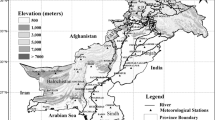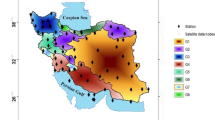Abstract
Drought is one of the complex meteorological disasters affecting water resources, agriculture, livestock, and socioeconomic patterns of a region. Although drought prediction is difficult, it can be monitored based on climatological information. In this study, we provide high spatiotemporal resolution drought climatology, using observational, gridded precipitation data (0.5°×0.5°) from the Global Precipitation Climatological Center and soil moisture data from the Climate Prediction Center for the 60-yr period 1951–2010. The standardized precipitation index (SPI) based on a fitted Gamma distribution and Run method has been calculated from the regional drought identification model (ReDIM) for 3, 6, 9, 12, and 24 months. The results show strong temporal correlations among anomalies of precipitation, soil moisture, and SPI. Analysis of long-term precipitation data reveals that the drought vulnerability concentrates on monsoon season (July–September), which contributes 72.4% and 82.1% of the annual precipitation in northern and southern Sindh, respectively. Annual and seasonal analyses show no significant changes in the observed precipitation. The category classification criteria are defined to monitor/forecast drought in the selected area. Further analysis identifies two longest episodes of drought, i.e., 1972–1974 and 2000–2002, while 1969, 1974, 1987, and 2002 are found to be the most severe historical drought years. A drought hazard map of Sindh was developed, in which 10 districts are recognized as highly vulnerable to drought. This study helps to explain the time, duration, intensity, and frequency of meteorological droughts over Sindh as well as its neighboring regions, and provides useful information to disaster management agencies and forecasters for assessing both the regional vulnerability of drought and its seasonal predictability in Pakistan.
Similar content being viewed by others
References
Adnan, S., 2009: Agro-climatic Classification of Pakistan. Master dissertation, COMSATS Institute of Information Technology, Islamabad, Pakistan. [Accessed 29 October, 2014] [Available online at https://www.researchgate.net/publication/261700354-Agroclimatic-Classification-of-Pakistan].
Adnan, S., and A. H. Khan, 2009: Effective rainfall for irrigated agriculture plains of Pakistan. Pakistan J. Meteor., 6, 61–72.
Asrari, E., M. Masoudi, and S. S. Hakimi, 2012: GIS overlay analysis for hazard assessment of drought in Iran using Standardized Precipitation Index (SPI). J. Ecol. Field Bio., 35, 323–329.
Becker, A., P. Finger, A. Meyer-Christoffer, et al., 2013: A description of the global land-surface precipitation data products of the Global Precipitation Climatology Centre with sample applications including centennial (trend) analysis from 1901 to present. Earth System Science Data, 5, 71–99.
Cancelliere, A., A. Ancarani, and G. Rossi, 1998: Distribuzioni di probabilità delle caratteristiche di siccità. Atti del XXVI Conv. di Idr. e Costr. Idrauliche, Catania, Italy, 9–12.
Dai, A. G., 2011: Drought under global warming: A review. Wiley Interdisciplinary Reviews: Climate Change, 2, 45–65.
Dai, A. G., K. E. Trenberth, and T. T. Qian, 2004: A global dataset of Palmer Drought Severity Index for 1870–2002: Relationship with soil moisture and effects of surface warming. J. Hydrometeor., 5, 1117–1130.
Dracup, J. A., K. S. Lee, and E. G. Paulson, Jr., 1980: On the definition of droughts. Water Resour. Res., 16, 297–302.
EM-DAT, 2013: The International Disaster Database, http://www.emdat.be/disaster-list, accessed on December 20, 2014.
Fan, Y., and H. Van Den Dool, 2004: The CPC global monthly soil moisture data set at 0.5 degree resolution for 1948-present. J. Geophys. Res., 109, D10102, doi: 10.1029/2003JD004345.
Fan, Y., and H. Van Den Dool, 2008: A global monthly land surface air temperature analysis for 1948–present. J. Geophys. Res., 113, D01103, doi: 10.1029/2007JD008470.
Fernández, B., and J. Salas, 1999: Return period and risk of hydrologic events. Part I: Mathematical formulation. J. Hydro. Eng., 4, 297–307.
Garcia-Herrera, R., E. Hernández, D. Barriopedro, et al., 2007: The outstanding 2004/05 drought in the Iberian Peninsula: Associated atmospheric circulation. J. Hydrometeor., 8, 483–498.
Giddings, L., M. Soto, B. M. Rutherford, et al., 2005: Standardized precipitation index zones for Mexico. Atmósfera, 18, 33–56.
Govement of Pakistan (GoP), 2014: Economic Survey of Pakistan (2013–14), Ministry of Finance, Government of Pakistan, Islamabad, Pakistan, 260 pp.
Guttman, N. B., 1994: On the sensitivity of sample L moments to sample size. J. Climate, 7, 1026–1029.
Hanif, M., A. H. Khan, and S. Adnan, 2013: Latitudinal precipitation characteristics and trends in Pakistan. J. Hydrol., 492, 266–272, doi: 10.1016/j.jhydrol.2013.03.040.
Helsel, D. R., and R. M. Hirsch, 1992: Statistical Methods in Water Resources. Elsevier, Amsterdam, 510 pp.
Huang, J., H. M. Van Den Dool, and K. G. Georgakakos, 1996: Analysis of model-calculated soil moisture over the US (1931–1993) and applications to longrange temperature forecasts. J. Climatol., 9, 1350–1362.
Kogan, F. N., 1997: Global drought watch from space. Bull. Amer. Meteor. Soc., 78, 621–636.
Kottegoda, N. T., 1980: Stochastic Water Resources Technology. The Macmillan Press, London, 384 pp.
Kumar, M. N., C. S. Muthly, M. V. R. Sesha, et al., 2009: On the use of Standardized Precipitation Index (SPI) for drought intensity assessment. Meteor. Appli., 16, 381–389.
Kurnik, B., P. Barbosa, and J. Vogt, 2011: Testing two different precipitation datasets to compute the standardized precipitation index over the Horn of Africa. Int. J. Remote Sens., 32, 5947–5964.
Liu Wenhuo, Gou Xiaohua, Yang Meixue, et al., 2009: Drought reconstruction in the Qilian Mountains over the last two centuries and its implications for largescale moisture patterns. Adv. Atmos. Sci., 26, 621–629.
Maher, J. V., 1967: Drought assessment by statistical analysis of rainfall. Aust. NZ Assoc. Adv. Sci. Symp. Drought, Melbourne, 57–71.
Maidment, D. R., 1993: Handbook of Hydrology. McGraw-Hill Inc., New York, 1424 pp.
Marengo, J. A., J. Tomasella, L. M. Alves, et al., 2011: The drought of 2010 in the context of historical droughts in the Amazon region. Geophys. Res. Lett., 38, doi: 10.1029/2011GL047436.
McKee, T. B., N. J. Doeskin, and J. Kleist, 1993: The relationship of drought frequency and duration to timescales. Proceedings of the 8th Conference on Applied Climatology. American Meteorological Society, Boston, MA, 179–184.
Mishra, A. K., and V. P. Singh, 2010: A review of drought concepts. J. Hydrol., 391, 202–216.
Mondal, A., S. Kundu, and A. Mukhopadhyay, 2012: Case study rainfall trend analysis by Mann-Kendall test: Case study of north-eastern part of Cuttack district, Orissa. Int. J. Geology Earth Environ. Sci., 2, 70–78. [Accessed 29 July, 2014] [Available online at http://www.cibtech.org/jgee.htm].
Muslehuddin, M., and N. Faisal, 2006: Long range forecast of Sindh monsoon. Pakistan J. Meteor., 3, 35–44.
Muslehuddin, M., H. Mir, and N. Faisal, 2005: Sindh Summer (June–September) monsoon rainfall prediction. Pakistan J. Meteor., 2, 91–108.
Narendra, B. H., 2008: Drought monitoring using rainfall data and spatial soil moisture modeling. Master dissertation, Gadja Mada University, India, 75 pp.
Pakistan Meteorological Department (PMD), 2013: Climatic Normal (1981–2010) of Pakistan. Karachi, 48–58.
Pietzsch, S., and P. Bissolli, 2011: A modified drought index forWMO RA VI. Adv. Sci. Res., 6, 275–279.
Raziei, T., I. Bordi, and L. S. Pereira, 2011: An application of GPCC and NCEP/NCAR datasets for drought variability analysis in Iran. Water Resources Management, 25, 1075–1086.
Rossi, G., and A. Cancelliere, 2003: At-site and regional drought identification by ReDIM model. Tools for Drought Mitigation in Mediterranean Regions. Springer, Kluwer Academic Publishing, Netherland, 37–54.
Rouault, M., and Y. Richard, 2003: Intensity and spatial extension of drought in South Africa at different timescales. Water SA, 29, 489–500.
Sen, P. K., 1968: Estimates of the regression coefficient based on Kendall’s tau. J. Amer. Statis. Assoc., 63, 1379–1389.
Sheffield, J., E. F. Wood, and M. L. Roderick, 2012: Little change in global drought over the past 60 years. Nature, 491, 435–438.
Spinoni, J., G. Naumann, H. Carrao, et al., 2014: World drought frequency, duration, and severity for 1951–2010. Int. J. Climatol., 34, 2792–2804. doi: 10.1002/joc.3875.
Svoboda, M., D. Lecomte, M. Hayes, et al., 2002: The drought monitor. Bull. Amer. Meteor. Soc., 83, 1181–1190.
United Nations Environment Programme (UNEP), 1998: Land Cover Assessment and Monitoring. Pakistan, 10-A, UNEP/EAP.TR/95-06, 50 pp.
Vogt, J. V., U. Safriel, G. Von Maltitz, et al., 2011: Monitoring and assessment of land degradation and desertification: Towards new conceptual and integrated approaches. Land Degradation & Development, 22, 150–165.
Vogt, J. V., and F. Somma, 2013: Drought and Drought Mitigation in Europe. Springer Science & Business Media, 328 pp.
Wilhite, D. A., 2012: Drought Assessment, Management, and Planning: Theory and Case Studies. Springer Science & Business Media, 262 pp.
Wilhite, D. A., and M. H. Glantz, 1985: Understanding: The drought phenomenon: The role of definitions. Water International, 10, 111–120.
World Meteorological Organization, 2012: Standardized Precipitation Index User Guide. M. Svoboda, M. Hayes, and D. Wood, Eds., WMO-No. 1090, Geneva, 24 pp.
Wu, H., M. J. Hayes, A. Weiss, et al., 2001: An evaluation of the standardized precipitation index, the China-Z-index and the statistical Z-score. Int. J. Climatol., 21, 745–758, doi: 10.1002/joc.658.
Yevjevich, V., 1967: An Objective Approach to Definitions and Investigations of Continental Hydrologic Drought. Colorado State University, Fort Collins, Colorado, 18 pp.
Zeng, N., 2003: Drought in the Sahel. Science, 302, 999–1000, doi: 10.1126/science.1090849.
Zhang Jianming, Zhang Xinping, Li Zuxian, et al., 2011: Spatial distribution and variation tendency of droughts and floods in Hunan Province during the past 36 years. J. Tropical Meteor., 17, 385–391.
Zheng, Y. C., 2000: Summaries of natural disasters across the globe. J. Dis. Reduc., 10, 14–19. (in Chinese)
Author information
Authors and Affiliations
Corresponding author
Additional information
Supported by the National Natural Science Foundation of China (91437215 and 41375052) and National Basic Research and Development (973) Program of China (2012CB417201).
Rights and permissions
About this article
Cite this article
Adnan, S., Ullah, K. & Gao, S. Characterization of drought and its assessment over Sindh, Pakistan during 1951–2010. J Meteorol Res 29, 837–857 (2015). https://doi.org/10.1007/s13351-015-4113-z
Received:
Accepted:
Published:
Issue Date:
DOI: https://doi.org/10.1007/s13351-015-4113-z




